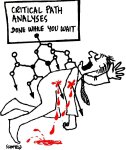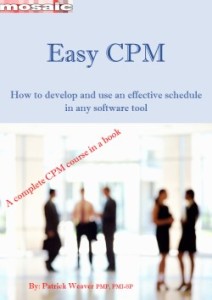
I’m wondering what is causing the confusion appearing in so many posts lately concerning the definition of the critical path. Is it:
- A lack of knowledge?
- People being out of date and using superseded definitions?
- People not understanding the difference between a characteristic and a definition?
As most people know (or should know) the definition used by the PMI Practice Standard for Scheduling (Third Edition), the International Standards Organization (ISO) and most other reputable authorities in their standards is similar to:
Critical Path: sequence of activities that determine the earliest possible completion date for the project or phase.
For more on the development of this definition see: Defining the Critical Path.
To deal with the questions above, in reverse order:
The difference between a characteristic and a definition.
The definition of a phrase or concept (the ‘critical path’ is both) should be a short, concise, statement that is always correct. A characteristic is something that indicates the concept may be present.
Everyone of significance has always agreed the critical path is the sequence of activities determining the earliest possible completion of the project (or if the project has staged completions, a stage or phase). This is the basis of the current valid definitions. As a direct consequence of this in a properly constructed CPM schedule, the float on the critical path is likely to be lower than on other paths but not always. Low float or zero float is a characteristic that is often seen on a critical path, but this is a consequence of its defining feature, it being longer than other paths.
Superseded definitions.

In the 1960s and 70s, most CPM schedules were hand drawn and calculated using a day number calendar. This meant there was only one calendar and constraints were uncommon. When there are no constraints and only a single calendar in use, the critical path has zero float! From the 1980s on, most CPM schedules have been developed using various software tool, all of which offer the user the option to impose date constraints and use multiple calendars (mainframe scheduling tools generally had these features from the 1960s on).
Using more than one calendar can cause different float values to occur within a single chain of activities, this is discussed in Calendars and the Critical Path.
Date constraints can create positive or negative float (usually negative) depending on the imposed date compared to the calculated date and the type of constraint, this is discussed in Negative Float and the Critical Path.
Consequently for at least the last 40 years, the definition of a critical path cannot be based on float – float changes depending on other factors.
Knowledge?
One of the problems with frequently repeated fallacies is when people do a reference search, they find a viable answer, and then use that information assuming the information is correct. This is the way we learn, and is common across all disciplines.
Academic papers are built based on references, and despite peer review process, can reference false information and continue to spread the falsehood. One classic example of this is the number of books and papers that still claim Henry Gantt developed the bar chart despite the fact bar charts were in use 100 year before Gantt published his books (which make no claim to him having invented the concept), for more on this see: https://mosaicprojects.com.au/PMKI-ZSY-020.php#Barchart. Another common falsehood is Henry Gantt ‘invented project management’ – his work was focused on improving factory production processes: https://mosaicprojects.com.au/PMKI-ZSY-025.php#Overview
Academics are trained researchers, and still make mistakes; the rest of us have a bigger challenge! The spread of un-reviewed publications via the internet in the last 20+ years started the problem. Now Generative AI (Gen AI) and large language models (LLM) are exacerbating the problem. For most of us it is getting harder and harder to understand where the information being presented a person, or in an article originated. Gen AI is built to translate data into language, it has no ability to determine if the data it has found is from a credible source or not. And as more and more text is produced by the various Gen AI tools the more often wrong information will be repeated making it more likely the wrong information will be found and repeated again, and again.
I’m not sure of the solution to this challenge Gen AI is clearly not skilled in project management practice (even the PMI AI tool), for more discussion on this important topic see: https://mosaicprojects.com.au/PMKI-SCH-033.php#AI-Discussion
Reference
One reference that is reliable is Mosaic’s Easy CPM. It incorporates most of what we know, focused on developing and using an effective schedule in any software tool. The book is designed to provide practical guidance to people involved in developing, or using, schedules based on the Critical Path Method (CPM), and act as a reference and practice guide to enhance the effectiveness of their scheduling practice.
For more see: https://mosaicprojects.com.au/shop-easy-cpm.php









